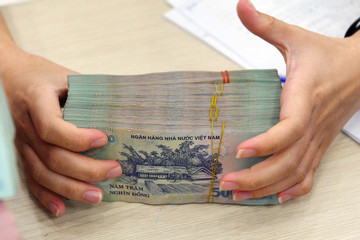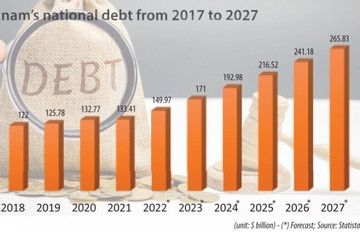- © Copyright of Vietnamnet Global.
- Tel: 024 3772 7988 Fax: (024) 37722734
- Email: evnn@vietnamnet.vn
public debt
Update news public debt
Public debt plan laid out towards 2026
Vietnam’s scheme for borrowing and paying public debt has been outlined, with diverse sources of loans in the pipeline and public debt set to stay within the permissible limit.
Government borrowings capped at VND690 trillion in 2024
The National Assembly has approved a resolution on 2024 State budget revenue, in which Government borrowings will be capped at VND690.5 trillion, up 6% over this year.
Public debt under ceiling level, but borrowed capital to pay rising principal
The National Finance and Budget Committee has predicted that public debts in 2024 will amount to 39-40 percent of GDP, government debts 37-38 percent and sovereign foreign debts 38-39 percent.
Government considers borrowing VND1.25 quadrillion over 2 years
The government has estimated that it would need to borrow VND1.25 quadrillion in the next two years, of which VND750 trillion would be used to cover the central budget over-expenditures, and VND465.8 trillion to pay due principal.
Public debt management picture clears towards 2025
Vietnam’s plan for borrowing and paying public debt has been revealed, and the budget landscape finalised for this year, with public debt set to stay within the permissible limit.
Vietnam’s public debt drops significantly
Vietnam’s public debt declined dramatically to 43.1 percent of GDP in 2021 from 58.3 percent in 2018, according to the Ministry of Finance.
Gov’t pays over VND 240 trillion in public debts
As of late October, the Vietnamese Government paid back VND 240 trillion (US$ 10.5 billion) in loans it owed domestically and internationally, according to the Ministry of Finance.
Vietnam’s public debt control goals for year within reach
Despite big spending, Vietnam will ensure its financial landscape is healthy with close control of public debt next year.
Public debt within safety line, gov't debt falls after currency depreciation
The government has submitted a report to the National Assembly on public debt in 2022 and predictions for 2023.
Government to borrow over VND644 trillion in 2023
The Government plans to borrow a total of VND644 trillion next year, around VND27 trillion higher than this year, according to a report to the National Assembly on public debt in 2022 and 2023.
Cost-cutting measures aid debt drop
Vietnam is witnessing a strong reduction in its public debt following its close control of the issue, with the government exercising a stringent policy on increasing revenues and reducing expenditures.
Vietnam’s public debt decreases significantly
Vietnam’s public debt in the 2017-2021 period decreased dramatically from 61.4% of its GDP to 43.1%, according to the latest information released by the Ministry of Finance.
An insight into Vietnam’s indebtedness
National debt, or foreign debt, when reaching an excessive level, often leads to an economic crisis.
Keeping public debt below 60 per cent of GDP by 2030 targeted
Vietnam is targeting to control public debt below 60 per cent of gross domestic product (GDP) by 2030 to ensure debt safety and national financial security.
VN manages to control public debt
Viet Nam managed to control public debt within a safe level with gradually slowing year-on-year increases. However, according to the Ministry of Finance, the economy was severely hit by the COVID-19 pandemic in the past three years.
Vietnam’s public debt totals VND3,500 trillion as of June 2021
Vietnam’s public debt, including the central Government’s debt, Government-guaranteed loans and loans of provinces, stood at over VND3,500 trillion as of June last year, according to the Ministry of Finance.
Government to borrow no more than VND673 trillion in 2022
The Ministry of Finance (MOF) has submitted a statement to the Prime Minister about the public debt management program for 2022-2024, and the plan to borrow and pay public debts in 2022.
Cat Linh-Ha Dong urban railway project and the problem of public debts
In the annual budget estimate submitted to the National Assembly, the Government always sets an increase in Vietnam's public debt payment obligations compared to the previous year.
VN reports public debt reaches VND3.7 quadrillion, plans to borrow VND571 billion next year
The Government’s report says that if the GDP in 2021 is below expectations, this will affect state budget overexpenditures as well as the national public debt and foreign debt safety indexes.
Robust regulations ahead for management of public debt
Vietnam will launch a revamp of its 2021-2025 budget management strategy, which is expected to ensure national security and control public debt.



















